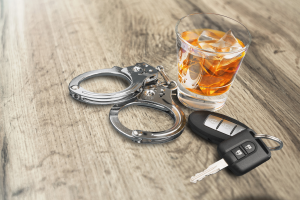Understanding the legal BAC limit in Ohio is critical for every driver. BAC, or blood alcohol concentration, measures how much alcohol is in your bloodstream, and exceeding Ohio’s limits can lead to an Operating a Vehicle Impaired (OVI) charge with severe consequences like fines, jail time, and license suspension. At Online Two Point Driving Classes, we’re here to break down these limits, explain the risks of crossing them, and show how our Ohio-approved online remedial course can help you stay safe and legal. Let’s dive into what Ohio law says about BAC, how it’s enforced, and what you can do to avoid trouble.
What Does BAC Mean and Why Does It Matter?
 BAC stands for blood alcohol concentration, expressed as a percentage of alcohol in your blood. It’s the key metric Ohio uses to define impairment behind the wheel. The legal BAC limit isn’t just a number—it’s a line between safe driving and a potential OVI, which can disrupt your life with legal and personal fallout. Alcohol affects everyone differently based on weight, gender, food intake, and drinking speed, but the law sets firm cutoffs to protect public safety.
BAC stands for blood alcohol concentration, expressed as a percentage of alcohol in your blood. It’s the key metric Ohio uses to define impairment behind the wheel. The legal BAC limit isn’t just a number—it’s a line between safe driving and a potential OVI, which can disrupt your life with legal and personal fallout. Alcohol affects everyone differently based on weight, gender, food intake, and drinking speed, but the law sets firm cutoffs to protect public safety.
Exceeding the legal BAC limit increases your crash risk dramatically. At 0.08%, the standard limit for most Ohio drivers, your reaction time slows, judgment fades, and coordination slips—making accidents far more likely. Ohio’s Department of Public Safety reports hundreds of alcohol-related deaths yearly, many tied to drivers over the limit. Knowing these limits isn’t just about avoiding tickets; it’s about keeping yourself and others safe.
Ohio’s Legal BAC Limits: Who Faces What?
Ohio tailors its legal BAC limit based on age, license type, and situation. Here’s the breakdown:
- Drivers 21 and Older: The legal BAC limit is 0.08%. Above this, you’re charged with a “per se” OVI, meaning the BAC alone proves impairment—no further evidence needed.
- Commercial Drivers: For those with a CDL, the limit drops to 0.04%. Hauling freight or passengers demands sharper focus, so the law cuts the threshold in half.
- Under 21: Ohio’s zero-tolerance policy sets the legal BAC limit at 0.02% for minors. Even a single drink can push you over, triggering an OVUAC (Operating a Vehicle After Underage Consumption) charge.
- High-Tier OVI: A BAC of 0.17% or higher—double the standard limit—kicks penalties into overdrive, even for a first offense.
These limits are tested via breath, blood, or urine if police suspect impairment. Ohio’s implied consent law means refusing a test isn’t an escape—it brings an immediate administrative license suspension (ALS) and can still lead to an OVI if other signs (like swerving or slurred speech) are present.
Penalties for Exceeding the Legal BAC Limit
Crossing Ohio’s legal BAC limit carries stiff penalties, escalating with BAC level and prior offenses. Here’s what you might face:
First Offense (BAC 0.08% – 0.169%)
- Jail Time: Minimum 3 days (or a 3-day driver intervention program), up to 6 months.
- Fines: $375 to $1,075, plus court costs.
- License Suspension: 1 to 3 years, with a 15-day “hard” period before limited privileges with an ignition interlock device (IID).
- Credit Points: 6 points added to your record, edging you toward the 12-point suspension threshold.
- Costs: A $475 reinstatement fee, plus IID expenses ($100 install, $60-$80 monthly).
First Offense (BAC 0.17%+)
- Jail Time: At least 6 days (or 3 days jail plus 3 days in a program).
- Fines: Higher within the $375-$1,075 range, often nearing the top.
Second Offense (Within 10 Years)
- Jail Time: 10 days minimum, up to 6 months; high-tier (0.17%+) means 20 days or house arrest.
- Fines: $525 to $1,625.
- License Suspension: 1 to 7 years, with a 45-day hard suspension.
- Vehicle: 90-day immobilization and mandatory IID.
Third Offense and Beyond
- Jail Time: 30 days to 1 year; felony status after three in 10 years, up to 5 years prison.
- Fines: $850 to $10,500.
- License Suspension: 2 years to permanent loss.
Refusal Penalties
- First Refusal: 1-year ALS, 30-day hard suspension.
- Subsequent Refusals: Up to 5 years, with hard periods stretching to 3 years.
Underage (BAC 0.02%+)
- Jail Time: Up to 30 days.
- Fines: Up to $250.
- Suspension: 3 months to 2 years.
- Credit Points: 4 points.
How Is the Legal BAC Limit Enforced?
Ohio enforces the legal BAC limit through roadside stops, sobriety checkpoints, and crash investigations. Officers use field sobriety tests—like walking a line or tracking a pen with your eyes—to spot impairment. If your BAC is suspect, a breathalyzer or lab test follows. Refusal triggers the ALS, and results over the limit mean an OVI charge on the spot. Courts don’t mess around—high-tier cases often face mandatory sentencing, and repeat offenders risk felony status.
The Real Costs of Going Over the Limit
Beyond penalties, surpassing the legal BAC limit hits hard. Insurance premiums can double or triple, adding thousands to your bills over years. Jobs requiring a clean record—like delivery or healthcare—might vanish. For students, scholarships or college acceptances could slip away. Socially, an OVI strains friendships and family trust, and if a crash happens, the guilt of injury or worse can haunt you forever. Our $69.95 online course at Online Two Point Driving Classes offers a way to recover, earning you a 2-point credit or meeting reinstatement needs from home.
Staying Under the Legal BAC Limit
Prevention beats punishment:
- Plan Ahead: Designate a sober driver or use ride-shares like Uber before drinking starts.
- Pace Yourself: Eat a solid meal—think burgers or pasta—and sip water between drinks to slow absorption.
- Track Your BAC: Use a breathalyzer app or device, but know impairment can hit below 0.08%.
- Stay Over: If you’re unsure, crash at a friend’s or grab a hotel—better safe than sorry.
- Host Wisely: Offer mocktails and monitor guests, arranging rides for anyone over the limit.

What If You’re Charged?
If you exceed the legal BAC limit and get caught:
- Cooperate minimally—give ID, but don’t admit guilt.
- Call a lawyer ASAP.
- Note details—time, officer’s actions, test conditions—for your defense.
- Appeal the ALS within 30 days at the BMV.
- Enroll in our course at Online Two Point Driving Classes for reinstatement or credit points.
Know Your Limit, Drive Smart—Join Us!
The legal BAC limit in Ohio is clear—don’t cross it. Stay informed and drive sober. Sign up for our 8-hour, Ohio-approved remedial course at Online Two Point Driving Classes for $69.95—earn a 2-point credit and keep your record clean! Check out our course to learn more or sign up today!
Q&A
- How does Ohio test for the legal BAC limit during a stop? Police use breathalyzers, blood, or urine tests to check if you’re over the legal BAC limit—0.08% for most drivers.
- Can weather affect staying under the legal BAC limit? Yes, drinking in cold weather can slow alcohol metabolism, making it harder to stay below the legal BAC limit.
- What’s the penalty for a minor exceeding the legal BAC limit? Under 21, a BAC over 0.02%—Ohio’s legal BAC limit for minors—means up to 30 days jail and 4 credit points.
- How does the legal BAC limit impact commercial drivers? Commercial drivers face a 0.04% legal BAC limit, half the standard, risking their CDL with even a small drink.
- Can our course help if I exceed the legal BAC limit? Yes, our $69.95, 8-hour online course at Online Two Point Driving Classes is a tool to help you get your license back if suspended, and earns a 2-point credit after an OVI.

Jim Trakas is a licensed instructor with the Ohio Department of Public Safety’s Driver Training Program. He has a distinguished history of public service, including his role as a former member of the Ohio House of Representatives and current Councilperson at Large for the City of Independence.
As the founder and owner of the American Online Learning Center, Jim has been providing comprehensive behavioral corrective programming since 2014, helping individuals achieve meaningful personal growth and development.
Jim’s commitment to service extends to his military background, where he has earned several prestigious honors. He was awarded the Ohio Commendation Medal by the Ohio Army National Guard and the Pandemic Campaign Medal by the United States Public Health Service. Additionally, he is an Honor Graduate of the Ohio Military Reserve Training Academy’s Officer Candidate School and a two-time recipient of the Military Proficiency Award, as well as the Military Achievement Award.


